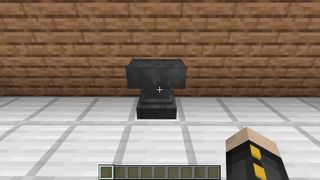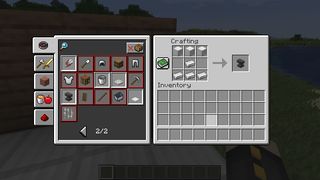How to make an anvil in Minecraft
Get smithing with this handy Minecraft anvil recipe guide.

How do you get your very own Minecraft anvil? Minecraft is changing all the time, and there are always new and exciting features to experience. It’s also why jumping in after a long break can lead to confusion. Not only do you remember where you left your house, you also need to learn all about the new items.
With this in mind, here's a little help with one such item, the anvil. So, here's the Minecraft anvil recipe so you can make one of your own, and then I'll show you how to use it.

How to make an anvil in Minecraft
Crafting the anvil requires a bit of legwork and a lot of iron. You'll need three Iron Blocks, and four Iron Ingots. If you've played Minecraft before, you'll know about Iron ingots. Just chuck some Iron Ore in a Furnace and voilà, Iron Ingots.
Iron Blocks are more of an issue. They only require Iron Ingots to make, but you need nine of them per block, which means you need 31 Iron Ingots in total. This might take a while.
Once you’ve got all of the items, use a crafting table and create your brand-new Anvil. Be careful not to drop it on your foot.
How to use the anvil in Minecraft

Minecraft update: What's new?
Minecraft skins: New looks
Minecraft mods: Beyond vanilla
Minecraft shaders: Spotlight
Minecraft seeds: Fresh new worlds
Minecraft texture packs: Pixelated
Minecraft servers: Online worlds
Minecraft commands: All cheats
Minecraft build ideas: What to build next
The anvil can be used in several ways. You can use it to rename an item, which is done by plopping said item onto it and typing in a new name. It costs at least one level to do this, though, so pick a name and stick to it.
You can also repair items with it. Put an item you want to repair on the left-hand side, then the materials needed to repair it on the right-hand side. This is where things get more complex, as you need to use the appropriate materials or a similar item to do so. For example, if you’re repairing a Diamond Sword, you need to use some Diamonds or another Diamond Sword to repair it. Be aware that any items on the right of the Anvil will be lost in the process.
The biggest gaming news, reviews and hardware deals
Keep up to date with the most important stories and the best deals, as picked by the PC Gamer team.
You can also use this method to transfer enchantments from one item to the other. This is a great way to create your own Excalibur, replete with a wealth of Minecraft enchantments that would make even the largest of Ender Dragons nervous. As before, the right-hand item will be sacrificed to make the left-hand item stronger, so ensure you're willing to part with the item before you commit to transferring the enchantment.
As for combining enchantments, doing so costs experience based on how powerful the enchantment is, as well as what level it is. So, make sure you’ve banked some experience before getting started.
One final point worth knowing, using an anvil can incur a Prior Work Penalty. The more you use an Anvil to enhance, combine, or repair items, the more expensive it becomes to do so. The first time you work on an object costs one level to do so, but every subsequent use will increase that cost exponentially. Here's a quick breakdown:
| Rework count | Level penalty |
|---|---|
| 1 | 1 |
| 2 | 3 |
| 3 | 7 |
| 4 | 15 |
| 5 | 31 |
| 6 | 68 |
| 7 | 127 |
As you can see, it gets expensive quickly. You can reset this by using the standard crafting grid to repair an item, but this will remove any enchantments you’ve added. It’s better to use a Minecraft grindstone to do this, as the item will keep its name and you’ll even get some experience back for the enchantments lost. In short, think before you tinker.

Palworld developer reports Nintendo's suing over 3 Pokémon patents for only $66,000 in damages, but a videogame IP lawyer says fighting the lawsuit could mean 'burning millions of dollars'

No Man's Sky gets cross-save on a dozen platforms and brings back Mass Effect's Normandy as a limited-time rewar
Most Popular

